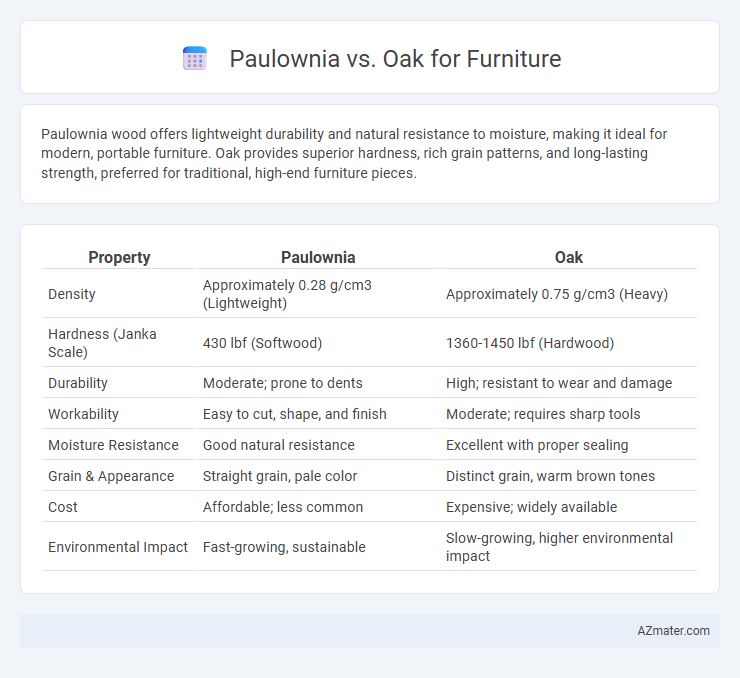Paulownia wood offers lightweight durability and natural resistance to moisture, making it ideal for modern, portable furniture. Oak provides superior hardness, rich grain patterns, and long-lasting strength, preferred for traditional, high-end furniture pieces.
Table of Comparison
| Property | Paulownia | Oak |
|---|---|---|
| Density | Approximately 0.28 g/cm3 (Lightweight) | Approximately 0.75 g/cm3 (Heavy) |
| Hardness (Janka Scale) | 430 lbf (Softwood) | 1360-1450 lbf (Hardwood) |
| Durability | Moderate; prone to dents | High; resistant to wear and damage |
| Workability | Easy to cut, shape, and finish | Moderate; requires sharp tools |
| Moisture Resistance | Good natural resistance | Excellent with proper sealing |
| Grain & Appearance | Straight grain, pale color | Distinct grain, warm brown tones |
| Cost | Affordable; less common | Expensive; widely available |
| Environmental Impact | Fast-growing, sustainable | Slow-growing, higher environmental impact |
Introduction to Paulownia and Oak for Furniture
Paulownia wood, known for its lightweight and rapid growth, offers exceptional dimensional stability and resistance to warping, making it ideal for modern furniture designs that prioritize ease of handling and eco-friendliness. Oak, a dense hardwood prized for its durability, rich grain patterns, and resistance to wear, has long been a staple in traditional and high-quality furniture production. Both woods provide distinct benefits: Paulownia supports sustainable manufacturing through fast renewability, while Oak delivers unmatched strength and classic aesthetics, guiding choices in furniture applications.
Wood Characteristics: Paulownia vs Oak
Paulownia wood is lightweight, soft, and highly resistant to warping and cracking, making it ideal for furniture that requires ease of handling and durability in varied climates. Oak, known for its density and hardness, offers exceptional strength, durability, and a distinct grain pattern, making it a preferred choice for long-lasting, heavy-use furniture. While Paulownia is valued for its rapid growth and eco-friendly properties, oak excels in structural integrity and classic aesthetic appeal.
Durability and Strength Comparison
Paulownia wood is significantly lighter and less dense than oak, making it easier to work with but less durable for heavy-use furniture. Oak, with its high density and hardness, provides superior strength and resistance to wear, ideal for long-lasting, sturdy furniture pieces. While Paulownia offers good dimensional stability and resistance to warping, oak outperforms it in load-bearing capacity and impact resistance, ensuring greater longevity.
Weight and Workability Differences
Paulownia wood is significantly lighter than oak, making it ideal for furniture that requires easy handling and portability, with a density of about 0.28 g/cm3 compared to oak's 0.75 g/cm3. The workability of paulownia is superior due to its soft texture and uniform grain, allowing for easier cutting, shaping, and finishing, while oak's hardness and coarse grain demand more effort and specialized tools. Paulownia's weight and workability advantages contribute to faster production times and reduced shipping costs, whereas oak offers superior durability and strength for heavy-use furniture.
Visual Appeal and Grain Patterns
Paulownia wood offers a light, pale color with subtle grain patterns, creating a modern and minimalist aesthetic ideal for sleek furniture designs. Oak features a richer, warm tone with prominent, intricate grain patterns that add character and a traditional, rustic charm to furniture pieces. The distinct visual appeal of Paulownia emphasizes simplicity and brightness, while oak's pronounced grains provide depth and texture.
Sustainability and Environmental Impact
Paulownia wood is highly sustainable due to its rapid growth rate, reaching maturity in 7-10 years compared to oak's 40-60 years, making it an eco-friendly choice for furniture production. Oak, while durable and strong, has a larger environmental footprint because of deforestation concerns and slower regeneration. The lighter weight of paulownia also reduces transportation emissions, further enhancing its environmental benefits over traditional oak furniture.
Cost and Availability
Paulownia wood is significantly more affordable than oak, making it a cost-effective option for budget-conscious furniture buyers. While oak is widely available and valued for its durability and classic grain patterns, paulownia's rapid growth and sustainability contribute to its increasing availability in the market. Oak's dense hardness ensures long-lasting furniture, but paulownia's lightweight nature also appeals for easily movable and modern-style pieces.
Finishing and Maintenance Requirements
Paulownia offers a smoother finish with minimal grain texture, allowing for easy application of stains and paints, while oak's dense, open grain demands more preparation for a uniform finish. Oak requires regular maintenance, including periodic sealing and polishing, to prevent moisture damage and maintain its rich appearance, whereas paulownia's natural resistance to rot and lightweight properties reduce upkeep needs. Choosing between paulownia and oak hinges on balancing the desired aesthetic finish and long-term maintenance commitment for furniture durability.
Suitability for Different Furniture Types
Paulownia wood, known for its lightweight and resistance to warping, is ideal for furniture requiring easy mobility such as storage chests and children's furniture. Oak, with its dense grain and durability, suits high-traffic pieces like dining tables and chairs that need to withstand heavy use. Choosing between Paulownia and Oak depends on whether the furniture prioritizes portability and moisture resistance or strength and long-term durability.
Final Verdict: Which Wood is Better for Furniture?
Paulownia offers lightweight durability and natural resistance to warping, making it ideal for furniture requiring portability and moisture resilience, while oak excels in strength, hardness, and classic aesthetic appeal, suited for heavy-use, long-lasting pieces. Oak's dense grain and robust structure provide superior scratch and dent resistance compared to Paulownia's softer texture. Choosing between Paulownia and Oak ultimately depends on whether weight and moisture resistance or strength and traditional appearance are the priority for the furniture intended.

Infographic: Paulownia vs Oak for Furniture
 azmater.com
azmater.com